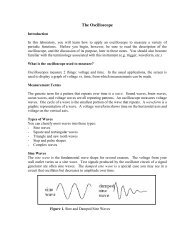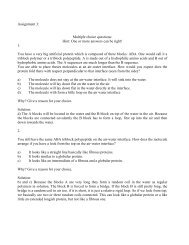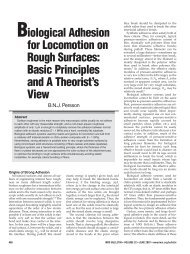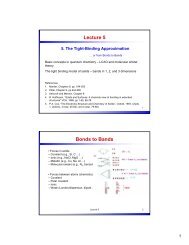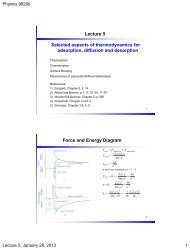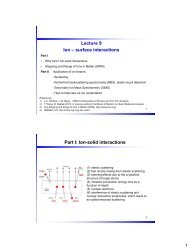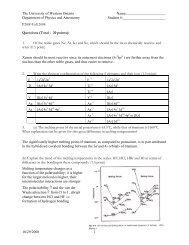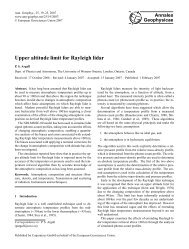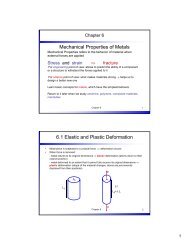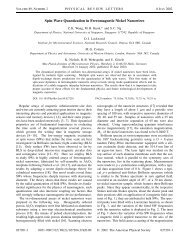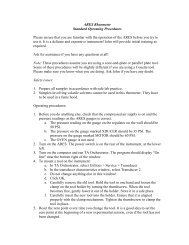Cartoon of growth
Cartoon of growth
Cartoon of growth
You also want an ePaper? Increase the reach of your titles
YUMPU automatically turns print PDFs into web optimized ePapers that Google loves.
Physics9826a<br />
Lecture 10<br />
Nucleation and <strong>growth</strong> <strong>of</strong> thin films and<br />
nanostructures<br />
10.1 Thermodynamics and kinetics <strong>of</strong> thin film <strong>growth</strong><br />
10.2 Defects in Films; Amorphous, polycrystalline and epitaxial films<br />
10.3 Vacuum film deposition techniques<br />
10.3.1 Physical Vapour Deposition (PVD)<br />
10.3.2 Molecular Beam Epitaxy (MBE)<br />
10.3.3 Chemical Vapour Deposition (CVD)<br />
10.4 Nanomaterials <strong>growth</strong> approaches: top-down and bottom-up.<br />
References:<br />
1) Zangwill, Chapter 16<br />
2) Luth, p.89-114<br />
3) Yates, pp. 627-668<br />
4) Kolasinski, Chapter 7<br />
Lecture 10 1<br />
10.1 Thermodynamics and kinetics <strong>of</strong> thin film <strong>growth</strong><br />
What is a “thin film”?<br />
How thin films are different from the bulk materials?<br />
Thin films may be:<br />
• Lower in density (compared to bulk analog)<br />
• Under stress<br />
• Different defect structures from bulk<br />
• Ultra-thin films (
Physics9826a<br />
Detailed steps in film formation<br />
1. Thermal accommodation<br />
2. Binding (physisorption and chemisorption)<br />
3. Surface diffusion (typically larger than bulk diffusion)<br />
4. Nucleation<br />
5. Island <strong>growth</strong><br />
6. Coalescence<br />
7. Continued <strong>growth</strong><br />
Nucleation and <strong>growth</strong> occurs on defects (or sites with higher bonding<br />
energy)<br />
Lecture 10 3<br />
Three different <strong>growth</strong> modes<br />
1. Island <strong>growth</strong> (Volmer – Weber)<br />
3D islands formation; film atoms more strongly bound to each other than to<br />
substrate and/ or slow diffusion<br />
2. Layer-by-layer <strong>growth</strong> (Frank – van der Merwe)<br />
generally the highest crystalline quality; film atoms more strongly bound to<br />
substrate than to each other and/or fast diffusion<br />
3. Stranski – Krastanov (mixed <strong>growth</strong>)<br />
initially layer-by-layer, then 2D islands<br />
Lecture 10 4<br />
Lecture 10 2
Physics9826a<br />
Thin film <strong>growth</strong> is not an equilibrium process!<br />
1. Thermodynamics (Gibbs Free energy and phase diagram): can the sold phase<br />
be formed at the given temperature?<br />
2. Kinetics (deposition rate and diffusion rate)<br />
Artificial superlattice is the best example <strong>of</strong> manipulating kinetics and<br />
thermodynamics<br />
Lecture 10 5<br />
10.2 Defects in Films<br />
Can be divided according to their geometry and shape<br />
• 0-D or point defects<br />
• 1-D or line defects (dislocations)<br />
• 2-D and 3D (grain boundaries, crystal twins, twists, stacking faults, voids<br />
and precipitates)<br />
Compression<br />
Edge<br />
dislocation<br />
line<br />
Tension<br />
Lecture 10 6<br />
Lecture 10 3
Physics9826a<br />
• 1D or linear defect - dislocations<br />
- edge dislocation<br />
- screw dislocation<br />
1D (Linear) defects<br />
• Edge dislocation (an extra partial plane <strong>of</strong> atoms)<br />
• there will be local lattice distortion (relaxed at long<br />
distance)<br />
• Strain fields (compression and tension)<br />
Compression<br />
Edge<br />
dislocation<br />
line<br />
Tension<br />
Mathematically slip or Burger vector b is<br />
used to characterize displacement <strong>of</strong> atoms<br />
around the dislocation<br />
b is perpendicular to the edge-dislocation line<br />
Lecture 10 7<br />
1D - Screw dislocation<br />
By following a loop <strong>of</strong> atoms around dislocation line ⇒ end up one<br />
plane up or down<br />
Burger vector is parallel to the screw dislocation line<br />
Lecture 10 8<br />
Lecture 10 4
Physics9826a<br />
Mixed edge and screw dislocations<br />
Most dislocations found in crystalline material are neither pure edge<br />
nor pure screw, but exhibit components <strong>of</strong> both types<br />
Lecture 10 9<br />
Crystal twins<br />
Grain boundary is not random, but have a symmetry (ex.:<br />
mirror)<br />
Stacking faults<br />
fcc: …ABCABC…<br />
…ABCABABCABC…<br />
3D defects<br />
Crystal twin<br />
Stacking fault<br />
Voids the absence <strong>of</strong> a number <strong>of</strong> atoms to form internal<br />
surfaces; similar to microcracks (broken bonds at the<br />
surface)<br />
Based on crystallinity:<br />
amorphous; polycrystalline and epitaxal (single crystal)<br />
Lecture 10 10<br />
Lecture 10 5
Physics9826a<br />
10.3 Vacuum film deposition techniques<br />
1. Physical Vapour Deposition (PVD)<br />
Evaporation: thermal and electron-beam assisted<br />
Sputtering: RF and DC Magnetron<br />
Pulsed Laser Deposition (PLD)<br />
3. Molecular Beam Epitaxy (MBE)<br />
2. Chemical Vapour Deposition (CVD)<br />
Plasma-Enhanced CVD (PE-CVD)<br />
Atomic Layer Deposition (ALD)<br />
⇒ Need good vacuum for thin film <strong>growth</strong>!<br />
Lecture 10 11<br />
10.3.1 Physical Vapour Deposition (PVD)<br />
Thermal Evaporation for non-refractory materials<br />
E-beam evaporation for refractory materials<br />
http://www.mdc-vacuum.com<br />
Lecture 10 12<br />
Lecture 10 6
Physics9826a<br />
http://www.mcallister.com/vacuum.html – see Lecture a larger 10 version attached in Appendix 13<br />
Sputtering Deposition<br />
• DC for conducting materials<br />
• RF for insulating materials<br />
Magnetron sputtering is most popular due to high rate and low operation<br />
pressure<br />
Lecture 10 14<br />
Lecture 10 7
Physics9826a<br />
Pulsed Laser Deposition (PLD)<br />
• Good for multielemental materials (P < 1 Torr)<br />
Lecture 10 15<br />
10.3.2 Molecular Beam Epitaxy (MBE)<br />
Molecular Beam Epitaxy<br />
(p < 10 -8 Torr)<br />
1. Elemental Superlattices: Giant<br />
Magneto-Resistiance (GMR)<br />
Devices<br />
2. Binary III-V Superlattices<br />
3. Complex Oxide Superlattices<br />
Lecture 10 16<br />
Lecture 10 8
Physics9826a<br />
Complex oxides are not that complex:<br />
Most <strong>of</strong> them are based on the ABO3 cubic perovskite structure<br />
Ex.:: SrTiO3, LaTiO3, LaMnO3, LaAlO3, …<br />
⇒ Favorable to atomically smooth layered heterostructures<br />
ABO3<br />
A: M2+ (Ca, Sr, Ba, La)<br />
B: M4+ (Ti, Zr, Mn)<br />
Lecture 10 17<br />
RHEED: the most critical tool for atomic- layer engineering<br />
RHEED oscillation showing completion <strong>of</strong> atomic layer <strong>growth</strong><br />
Lecture 10 18<br />
Lecture 10 9
Physics9826a<br />
SrTiO 3 /BaTiO 3 /CaTiO 3<br />
M. Warusawithana, J. Zuo, H. Chen<br />
and J. N. Eckstein<br />
Superlattices grown by MBE<br />
LaTiO 3 /SrTiO 3 (PLD)<br />
A. Ohtomo, H. Y. Hwang, Nature 419, 378<br />
(2002)<br />
Lecture 10 19<br />
Epitaxial oxide material integrated with Si<br />
1. Sc 2 O 3 /Si(111)<br />
2. SrTiO 3 /Si(001)<br />
SrTiO<br />
Si<br />
5n<br />
m<br />
• Epitaxial structures may afford<br />
controllable interfaces (no dangling<br />
bonds…)<br />
• Demonstration <strong>of</strong> interface stability and<br />
identification <strong>of</strong> potential stability<br />
problems under oxidizing/reducing<br />
conditions<br />
3<br />
Epitaxial vs amorphous or polycrystalline<br />
Lecture 10 20<br />
Lecture 10 10<br />
?<br />
Sr<br />
Ti<br />
O<br />
Si
Physics9826a<br />
10.3.3 Chemical Vapour Deposition (CVD)<br />
Precursors are needed!<br />
CH 4 (g) → SWNT + H 2 (g) ~ 700 o C, Fe, Ni catalysts<br />
SiH 4 (g) → Si + 2 H 2 (g)<br />
Si(OC 2 H 5 ) 4 (g) → SiO 2 (s) + (C 2 H 5 ) 2 O (g)<br />
Lecture 10 21<br />
Atomic Layer Deposition<br />
H 2 O<br />
HCl<br />
MCl 4 (ads, surf) + 2 H 2 O(g) → MO 2 (s) + 4HCl(g)<br />
M(N(CH 3 )(C 2 H 5 )) 4 (ads, surf) + O 3 (g) → MO 2 (s) + …<br />
•Surface saturation controlled process<br />
•Excellent film quality and step coverage<br />
1. MCl 4 exposure<br />
2. Purge<br />
3. H 2 O exposure<br />
4. Purge ⇒ MO 2 ML<br />
Lecture 10 22<br />
Lecture 10 11<br />
Si
Physics9826a<br />
10.4 Nanomaterials <strong>growth</strong> methods<br />
Patterning in bulk materials by<br />
combination <strong>of</strong><br />
Lithography<br />
Etching<br />
Deposition<br />
Two approaches<br />
Top-down Bottom-up<br />
- can be applied for variety <strong>of</strong> materials<br />
- limited by lithography resolution,<br />
selectivity <strong>of</strong> etching, etc.<br />
Structure is assembled from well-defined<br />
chemically or physically synthesized<br />
building blocks<br />
Self-assembly<br />
Selective <strong>growth</strong><br />
- require accurate control and tunable<br />
chemical composition, structure, size and<br />
morphology <strong>of</strong> building blocks<br />
- in principle limited only by atomic<br />
dimensions<br />
Lecture 10 23<br />
Mechanical Methods (Mechanosynthesis)<br />
Low cost fabrication: ball milling or shaker milling<br />
Kinetic energy from a rotating or vibrating canister is imparted to hard spherical<br />
ball bearings (under controlled atmosphere)<br />
(1) Compaction and rearrangement <strong>of</strong> particles<br />
(2) First elastic and then severe plastic deformation <strong>of</strong><br />
the sample material ⇒ formation <strong>of</strong> defects and<br />
dislocations<br />
(3) Particle fracture and fragmentation with continuous<br />
size reduction ⇒ formation <strong>of</strong> nanograined material<br />
1 K IC γE<br />
K IC = Yσ<br />
F πa<br />
σ F ~<br />
~<br />
Y a a<br />
σF – stress level, when crack propagation leads to<br />
fracture; γ - surface energy <strong>of</strong> the particle; a - length<br />
<strong>of</strong> a crack<br />
-material with defects with a wide distribution <strong>of</strong> size<br />
Lecture 10 24<br />
Lecture 10 12
Physics9826a<br />
High-Energy Methods: Discharge Plasma Method<br />
Application <strong>of</strong> high energy electric current (monochromatic radiation – laser ablation)<br />
Can be used for fullerenes and C nanotubes<br />
Process depend on:<br />
-Pressure <strong>of</strong> He, process temperature,<br />
applied current<br />
final product requires extensive purification<br />
Lecture 10 25<br />
Structure <strong>of</strong> the carbon nanotubes<br />
armchair<br />
zig-zag<br />
Lecture 10 26<br />
Lecture 10 13<br />
chiral
Physics9826a<br />
Carbon Nanotubes<br />
The structure can be specified by vector (n, m)<br />
which defines how the graphene sheet is rolled up<br />
A nanotube with the indices (6,3): the sheet is<br />
rolled up so that the atom (0,0) is superimposed<br />
on the one labeled (6,3)<br />
m = 0 for all zig-zag tubes, while n = m for all<br />
armchair tubes<br />
Lecture 10 27<br />
Chemical Fabrication Methods<br />
Anodizing (and electropolishing)<br />
Insulating porous oxide layer is created on a conductive metal anode in electrolytic solution<br />
Porous Al 2 O 3 membranes can be<br />
considered as ultimate template material<br />
Anodic reaction 2Al 0 (s) → 2 Al3+ + 6e<br />
Oxide-electrolyte interface 2 Al 3+ + 3H 2 O → 2 Al 2 O 3 + 6H +<br />
Cathodic reaction 6H + + 6e → 3 H 2 (g)<br />
Overall oxide formation reaction:<br />
2Al 0 (s) + 3H 2 O → Al 2 O 3 + 3 H 2<br />
Lecture 10 28<br />
Lecture 10 14
Physics9826a<br />
Lithographic Methods<br />
Lecture 10 29<br />
Top-bottom: High-Aspect Aspect-Ratio Si Structures<br />
nanotextured Si surface dense silicon pillar array<br />
Lecture 10 30<br />
Lecture 10 15
Physics9826a<br />
Bottom-up: vapor-liquid-solid <strong>growth</strong><br />
VLS <strong>growth</strong> <strong>of</strong> Ge NWsw/Au<br />
Metallic<br />
catalyst<br />
nanocluster<br />
• Metal particle catalyzed the decomposition <strong>of</strong> a<br />
gaseous species containing the semiconductor<br />
components, e.g. Ge, or Ga and As<br />
• Metal catalyst particles absorb species,<br />
becoming saturated with them at eutectic point<br />
(relatively low temperature)<br />
• When semiconductor reaches supersaturation,<br />
it precipitates out <strong>of</strong> the eutectic<br />
• Metal prepared and deposited/grown on surface<br />
• Metal droplet size determines eventual wire<br />
diameter<br />
Lecture 10 (from E. Garfunkel) 31<br />
<strong>Cartoon</strong> <strong>of</strong> <strong>growth</strong><br />
Eutectic (AuGe alloy)<br />
Temperature is<br />
controlled to keep it in<br />
the liquid state<br />
Nanowire<br />
nucleation begins<br />
when the liquid<br />
become saturated<br />
with Ge<br />
Nanowire <strong>growth</strong><br />
continues as long<br />
as Au-Ge alloy stays<br />
liquid and Ge<br />
concentration is high<br />
enough<br />
Lecture 10 32<br />
Lecture 10 16
Physics9826a<br />
Electrochemical step decoration<br />
- minimization surface energy <strong>of</strong> the step<br />
- metal oxide electrochemical deposition + reduction (H2)<br />
- metal electrochemical deposition<br />
Lecture 10 33<br />
Designed Synthesis <strong>of</strong> Hierarchical Structures<br />
The evolution <strong>of</strong> nanowire structural and compositional complexity<br />
enabled today by controlled synthesis<br />
(a) from homogeneous materials<br />
(b) axial and radial heterostructures<br />
(c) branched heterostructures<br />
The colors indicate regions with distinct chemical composition and/or doping<br />
Lecture 10 34<br />
Lecture 10 17
Physics9826a<br />
Organization and Assembly <strong>of</strong> Nanowires<br />
Using a patterned catalyst, NWs can be directly grown on a solid substrate in a<br />
designed configuration<br />
NW materials produced under synthetic conditions optimized for their <strong>growth</strong><br />
can be organized into arrays by several techniques<br />
(1) electric - field – directed (highly anisotropic structures and large polarization)<br />
(2) fluidic - flow – directed (passing a suspension <strong>of</strong> NWs through micr<strong>of</strong>luidic<br />
channel structure)<br />
(3) Langmuir–Blodgett (ordered monolayer is formed on water and transferred<br />
to a substrate)<br />
(4) patterned chemical assembly or imprint<br />
Lecture 10 35<br />
Imprint based patterning <strong>of</strong> metal nanoparticles<br />
Lecture 10 36<br />
Lecture 10 18
Physics9826a<br />
( 1)<br />
Lecture 10, continued<br />
Nucleation and <strong>growth</strong> <strong>of</strong> thin films and<br />
nanostructures<br />
10.5 Capillary Model <strong>of</strong> Nucleation<br />
10.6 Homogeneous Nucleation Kinetics<br />
10.7 Epitaxy<br />
10.8 Experimental Approaches<br />
Rate ∝ν × e<br />
−<br />
E<br />
kT<br />
References:<br />
1) Zangwill, Chapter 16<br />
2) Luth, p.89-114<br />
3) C.T. Campbell, Surf. Sci. Reports 27 (1997) 1-111<br />
4) Kolasinski, Chapter 7<br />
Lecture 10 37<br />
Phenomenological Description <strong>of</strong> Growth Modes<br />
A simple formal distinction between the conditions for <strong>growth</strong> can be given in terms <strong>of</strong><br />
surface and interface energies:<br />
γ = γ + γ cosΦ<br />
S / F F<br />
The limiting <strong>growth</strong> modes, layer-by-layer (FM) and island <strong>growth</strong> (VW) are given by:<br />
layer <strong>growth</strong><br />
( 2)<br />
island <strong>growth</strong><br />
o<br />
Φ = 0 γ > γ + γ<br />
S<br />
o<br />
Φ > 0 γ < γ + γ<br />
S<br />
F<br />
F<br />
S / F<br />
S / F<br />
Mixed <strong>growth</strong> (SK) is due to a transition from layer to island <strong>growth</strong> from competition<br />
between elastic deformation and the range <strong>of</strong> adhesion forces (e.g., lattice mismatch)<br />
p<br />
If we include the degree <strong>of</strong> supersaturation during the <strong>growth</strong> - b =<br />
po<br />
( 1)<br />
layer <strong>growth</strong> γ S ≥ γ F + γ S / F + const × kT ln ⇒ <strong>growth</strong> mode <strong>of</strong> a film is not constant,<br />
p<br />
p<br />
Can be varied by supersaturation conditions; for<br />
o<br />
( 2)<br />
island <strong>growth</strong> γ S < γ F + γ S / F + const × kT ln<br />
Lecture high<br />
p 10rate onto low T b ~ 10 38<br />
20<br />
Lecture 10 19<br />
S<br />
po
Physics9826a<br />
Δ<br />
10.5 Homogeneous Capillary Model <strong>of</strong> Nucleation<br />
G total<br />
3<br />
4 Πr<br />
2<br />
= Δμ<br />
+ 4Πr<br />
γ<br />
3 ν<br />
∆G total – total free-energy change<br />
r – radius <strong>of</strong> embryo or nucleus<br />
∆µ – volume free energy<br />
γ - specific surface free energy<br />
Two components: (i) volume freeenergy<br />
change (∆G V or ∆µ) and (ii)<br />
surface free-energy change (∆G S )<br />
Δ μ = μ − μ < 0;<br />
μ < μ<br />
S<br />
(i) is negative,<br />
S<br />
L<br />
(ii) ΔG S is positive<br />
L<br />
r* - critical radius<br />
-if r < r*, droplet can shrink or dissolve<br />
-if r > r*, droplet grows<br />
Lecture 10 39<br />
Critical radius, r*<br />
We can find the value <strong>of</strong> the critical radius by setting:<br />
3<br />
2<br />
∂ΔGT<br />
∂ ⎛ 4 Πr<br />
2 ⎞ 4 Πr<br />
= 0 =<br />
μ r γ = Δμ<br />
+ × Πrγ<br />
r r<br />
⎜ Δ + 4Π<br />
v<br />
⎟ 3 4 2<br />
∂ ∂ ⎝ 3<br />
⎠ 3 v<br />
2<br />
4Πr<br />
Δμ<br />
= −8Πrγ<br />
v<br />
* 2γ<br />
× v<br />
r = −<br />
Δμ<br />
Growth cannot proceed until a droplet with<br />
radius at least as large as r* forms<br />
The energy <strong>of</strong> this critical nucleus relatively to<br />
the liquid phase is:<br />
3 2<br />
* 16Πγ<br />
v<br />
ΔG<br />
= 2<br />
( Δμ)<br />
r* decreases as T C ↓; ΔH C ↑ , or γ ↑<br />
when r = r*<br />
Lecture 10 40<br />
Lecture 10 20
Physics9826a<br />
10.6 Homogeneous Nucleation Kinetics<br />
(a) Nucleation in 1st layer: compact islands<br />
The model:<br />
- assume nucleation in layer 1 and slow adatom desorption<br />
- assume critical nucleus is 1 atom, so that a dimer, once formed, will not dissociate. New<br />
adatoms can form new nuclei by collision with another adatom, or can add to existing<br />
nuclei<br />
- calculate saturation density N <strong>of</strong> nuclei<br />
N is reached when adatom diffuses distance L to find existing nucleus before meeting<br />
another atom<br />
The diffusion time τ L over distance L, diffusion coefficient D is<br />
2<br />
L<br />
τ L =<br />
D<br />
Rate<br />
Rate<br />
attach<br />
flux<br />
A×<br />
n<br />
=<br />
τ<br />
= A×<br />
F<br />
Campbell, Surf. Sci. Rep. 27 (1997) 1-111<br />
L<br />
2D<br />
Lecture 10 41<br />
Homogeneous Nucleation Kinetics<br />
- At steady state, when no new nuclei are created<br />
Rate = Rate<br />
flux<br />
n2D<br />
n2D<br />
D<br />
A×<br />
F = A = A 2<br />
τ L<br />
L<br />
attach<br />
2<br />
Solve for n2D :<br />
L<br />
n2 D = τ LF<br />
= F<br />
D<br />
- Assume two atoms for a dimer when they sit on adjacent sites separated by a<br />
D<br />
2<br />
Ratedim<br />
er = A×<br />
n2D<br />
× khop<br />
× pocc<br />
= A×<br />
n2D<br />
× × 4n2Da<br />
2<br />
a<br />
2<br />
Rate = 4ADn<br />
Rate<br />
4Dn<br />
dimer<br />
dimer<br />
2D<br />
= 4ADn<br />
L<br />
2D<br />
2<br />
2D<br />
Physics9826a<br />
10.7 Epitaxy<br />
Epitaxy (“arrangement on”) refers loosely to control <strong>of</strong> the orientation <strong>of</strong> the<br />
growing phase by the crystal structure <strong>of</strong> the substrate<br />
homoepitaxy: host and growing phase are the same material<br />
heteroepitaxy: host and growing phase are different<br />
Orientation and Strain<br />
There exist orientational relations between dissimilar crystal lattices in contact<br />
(e.g., fcc (111)/bcc (110); fcc (100) /rocksalt (100)<br />
Nishiyama-<br />
Wasserman<br />
Kurdjimov<br />
-Sachs<br />
Lecture 10 Zangwill, Ch.16 43<br />
Epitaxial energy<br />
NW: Θ = 0 o , row-matching parallel to [001] bcc<br />
KS: Θ = 5.26 o , rotational epitaxy<br />
Epitaxial energy at interface calculated<br />
using Lennard-Jones pairwise 6-12 potential<br />
Note minima for 0 o and ~ 5 o<br />
E is indep. <strong>of</strong> r = a/b for other angles<br />
Definition <strong>of</strong> misfit:<br />
a − b<br />
f =<br />
a<br />
Heterointerface between 2 diff. crystals:<br />
the lattice mismatch is adjusted by<br />
edge dislocations or strain<br />
Lecture 10 Zangwill, Ch.16 44<br />
Lecture 10 22
Physics9826a<br />
Strained vs Dislocations<br />
The type <strong>of</strong> interface (strained vs dislocations) depends on the thickness <strong>of</strong> the film and<br />
lattice mismatch, f.<br />
The energy stored in an interface between epitaxial film and substrate is calculated from<br />
the relative contributions <strong>of</strong> elastic strain (deformation <strong>of</strong> the lattice <strong>of</strong> the film) and<br />
formation <strong>of</strong> edge dislocations<br />
Left: film thickness = const.<br />
Right: misfit = const.<br />
Often, pseudomorphic <strong>growth</strong> is found for the first monolayer or so in metals on<br />
metals (i.e., overlayer adopts atomic arrangements <strong>of</strong> substrate)<br />
As film thickness ⇑, complexities develop….<br />
Lecture 10 45<br />
Structural phase diagram<br />
We can illustrate the complexity <strong>of</strong> <strong>growth</strong> in the case <strong>of</strong> fcc(111)/bcc(110)<br />
inteface in plot <strong>of</strong> r vs λ<br />
a<br />
r<br />
=<br />
b<br />
coupling strenth within<br />
film<br />
λ =<br />
interlayer coupling strenth<br />
Lecture 10 46<br />
Lecture 10 23
Physics9826a<br />
10.8 Experimental Studies <strong>of</strong> Layer and Cluster Growth<br />
• Microscopic: STM, AFM, HRSEM<br />
• Surface Spectroscopy: LEIS, AES, XPS<br />
• Diffraction: RHEED oscillations; LEED<br />
STM AFM/<br />
Filinomov, et al Phys.Rev.B 76 (2007) 035428<br />
SEM<br />
Gsell, et al Diamond and related materials, 2007<br />
Lecture 10 47<br />
AES and XPS<br />
For simple continuum description <strong>of</strong> layer <strong>growth</strong>: signal I, thickness h, electron<br />
mean free path λ:<br />
dI d × h<br />
= −<br />
I λ<br />
F<br />
h<br />
−Θd<br />
I<br />
−<br />
−<br />
λ<br />
λ<br />
For overlayer film = 1−<br />
e = 1−<br />
e<br />
F<br />
I<br />
For substrate:<br />
∞<br />
I<br />
I<br />
S<br />
S<br />
∞<br />
= e<br />
−Θd<br />
−<br />
λ<br />
where Θ is coverage in ML, and d is thickness <strong>of</strong> 1 ML. Within single ML:<br />
Lecture 10 48<br />
Lecture 10 24<br />
F<br />
I<br />
∝ Θ
Physics9826a<br />
Low Energy Ion Scattering (LEIS)<br />
… as a tool for thin film <strong>growth</strong> characterization<br />
Expected behavior:<br />
Layer Cluster<br />
Growth Growth<br />
F. Pesty, et al, Surf.Sci. 339 (1995) 83<br />
LEIS is highly surface sensitive due to high<br />
neutralization probability<br />
E'<br />
⎛ 1 m2<br />
− m ⎞ 1 = ⎜<br />
⎟<br />
Eo<br />
⎝ m1<br />
+ m2<br />
⎠<br />
“Billiard ball” collisions; for direct<br />
backscattering<br />
Lecture 10 49<br />
Low Energy Ion Scattering (LEIS)<br />
F. Pesty, et al, Surf.Sci. 339 (1995) 83<br />
Lecture 10 50<br />
Lecture 10 25<br />
2



